

- UPDATE: we now offer a detailed How to Preserve & Store Wild Edibles booklet -
Ideally you should eat fresh wild edibles; however winter tends to put a halt to that. There are several methods to preserving your harvest so you can enjoy nature’s goodness throughout the cold months:
Blanching and Freezing Food
Some wild edibles require blanching before freezing (such as lamb’s quarters) and it’s best to research which ones. Others you can freeze as is.
Freezing is one of the easiest methods to preserving your harvest. Rinse the plants quickly in cold water, shake off excess water, and then chop coarsely. Place the chopped plant into ice cube trays and freeze. Once frozen, transfer the plant-cubes into freezer bags or air tight plastic containers.
Another method for freezing is to spread the wild edible loosely onto a baking sheet to freeze. Once frozen transfer the wild edibles into a freezer bag and seal.
When they thaw, the wild edibles cannot be used in a salad, but they can be used in cooking. Do not re-freeze after thawing.
Drying Food

Drying is the traditional method of plant preservation. If the wild edibles are clean, do not wet them. Otherwise, briefly rinse dust and dirt from the foliage, shake off the excess water, and remove any dead or damaged foliage.
Then, tie the stems into small bundles with string or elastic bands and hang them upside down in a warm, dry, airy place in your home or outside - but not in direct sunlight. Be sure to make small, loose bundles and allow for good air circulation around each bunch. Elastic bands are the preferable method because as the stems dry, they lose moisture, therefore shrinking; the elastic band will automatically readjust to the size of the stems. Paperclips can be used to hang the bundles on a string or rope.
UV rays from the sun and moisture from dew and frost can discolour and reduce the quality of many herbs. Thus, it is best to dry herbs indoors in a large empty closet, attic, or unused corner of a room. Drying herbs actually add a wonderful natural scent to a room.

An alternative to hanging your plants to dry is to spread them out on a clean window screen or homemade screen. A window screen can rest on the backs of chairs – having as much air flow as possible is important. Turn the leaves often to ensure even drying.
Conventional ovens can also be used to dry wild edibles. Spread the plant evenly on a baking sheet and dry at the lowest temperature setting possible. Home food dehydrators also do an excellent job. Follow the directions provided with the dehydrator.
Wild edibles are sufficiently dry when they are brittle and crumble easily. When the leaves are dry, separate them from their stems (unless the stem possesses nutritional values). Store the dried plant in mason jars with tight fitting lids. Heavy-duty zip-lock plastic bags can also be used.
Store dried wild edibles in a cool, dry place away from sunlight, moisture, and heat. Average shelf life is one to two years if stored properly.
Dried wild edibles will not only increase the nutritional value of soups, stews, potato dishes, pancakes, and much more but they will add flavour too!
Winter Survival Food Handbook

PDF Plant Magazines
Types of Wild Food
Geographic Zones Seasons
Disclaimer
EdibleWildFood.com is informational in nature. While we strive to be 100% accurate, it is solely up to the reader to ensure proper plant identification. Some wild plants are poisonous or can have serious adverse health effects.
We are not health professionals, medical doctors, nor are we nutritionists. It is up to the reader to verify nutritional information and health benefits with qualified professionals for all edible plants listed in this web site. Please click here for more information.
Why Edible Wild Food?
- Food costs are rising
- Free, wild food is readily abundant
- Wild food adds nutrition to your diet
- Wild food can help treat various medical conditions





